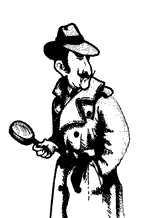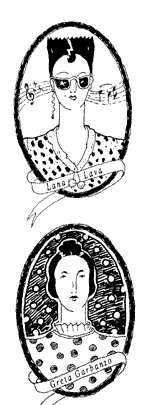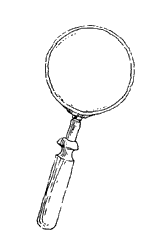|
All of the books below depict mysteries. While some are simple
and others more complex, they all share in the collection of evidence
or clues, and use analysis to make inferences or conclusions.
The distinction between evidence and inference is made in the
Crime Lab Chemistry unit and comes alive through application
to a diverse collection of mysterious situations, as in these
stories. Several of the books involve the use of chromatography
or its related concepts, such as solubility.
Some teachers use newspaper articles with their students, which
describe a crime (usually unsolved), the evidence, and some possible
inferences. There are books containing nonfiction accounts of
mysteries or scientific discoveries, in which detective-like behavior
was required. Such a mystery would be particularly apt if it involved
chromatographic analysis of evidence.
There are numerous other books that focus on solving mysteries.
The process of science is, after all, parallel to that of detection
and making inferences to solve a problem. These other books include
several well-known collections such as the “Encyclopedia
Brown” series and “One-minute mysteries.” You and
your students probably have your own favorites.
We would especially welcome hearing about those
that include details of scientific tests and evaluation of evidence
similar to those in the GEMS guides.
Cam Jensen and the Mystery of the Gold Coins
Chip Rogers: Computer Whiz
Einstein Anderson Science Sleuth
From the Mixed-Up Files of Mrs. Basil E. Frankweiler
The Great Adventures of Sherlock Holmes
The Missing ‘Gator of Gumbo Limbo: An Ecological
Mystery
Motel of the Mysteries
The Mystery of the Stranger in the Barn
The One Hundredth Thing About Caroline
The Real Thief
Susannah and the Blue House Mystery
Susannah and the Poison Green Halloween
The Tattooed Potato and Other Clues
The Westing Game
Who Really Killed Cock Robin?
Cam Jensen and the Mystery of the Gold
Coins
by David A. Adler; illustrated by Susanna Natti
Viking Press, New York. 1982
Dell Publishing, New York. 1984
Grades: 3–5
Cam Jensen uses her photographic memory to solve a theft of
two gold coins. Cam and her friend Eric carry around their 5th
grade science projects throughout the book and the final scenes
take place at the school science fair. (Other titles in this series
include Cam Jensen and the Mystery at the Monkey House
and Cam Jensen and the Mystery of the Dinosaur Bones in
which she notices that three bones are missing from a museum’s
mounted
dinosaur.)
Return to title list.
Chip Rogers: Computer Whiz
by Seymour Simon; illustrated by Steve Miller
William Morrow, New York. 1984
Out of print
Grades: 4–8
Two youngsters, a boy and a girl, solve a gem theft from a
science museum by using a computer to classify clues. A computer
is also used to weigh variables in choosing a basketball team.
Although some details about programming the computer may be a
little dated, this is still a good book revolving directly around
sorting out evidence, deciding whether or not a crime has been
committed, solving it, and demonstrating the role computers can
play in human endeavors. By the author of the Einstein Anderson
series.
Return to title list.
Einstein Anderson Science Sleuth
by Seymour Simon; illustrated by Fred Winkowski
Viking Press, New York. 1980
Grades: 4–7
In the “Universal Solvent” chapter, Einstein Anderson’s
friend Stanley tries to convince him that the cherry soda-looking
liquid he has invented will dissolve anything. In Session 2 of
this GEMS guide, students analyze chromatograms looking at variables
such as the type of solvent used and the test substance used.
Return to title list.
From the Mixed-Up Files of Mrs. Basil
E. Frankweiler
by E.L. Konigsburg
Atheneum, New York. 1967
Dell Publishing, New York. 1977
Grades: 5–8
Twelve-year-old Claudia and her younger brother run away from
home to live in the Metropolitan Museum of Art and stumble upon
a mystery involving a statue attributed to Michelangelo. This
book is a classic, and has been recommended to GEMS by many teachers.
Return to title list.
The Great Adventures of Sherlock Holmes
by Arthur Conan Doyle
Viking Penguin, New York. 1990
Grades: 6-Adult
These classic short stories are masterly examples of deduction.
Many of the puzzling cases are solved by Holmes in his chemistry
lab as he analyzes inks, tobaccos, mud, etc. to solve the crime
and catch the criminal. Nearly every Sherlock Homes story is suitable
for this GEMS guide. These stories are available from many different
publishers and in many editions.
Return to title list.
The Missing ‘Gator of Gumbo Limbo:
An Ecological Mystery
by Jean C. George
HarperCollins, New York. 1992
Grades: 4–7
Sixth-grader Liza K and her mother live in a tent in the Florida
Everglades. She becomes a nature detective while searching for
Dajun, a giant alligator who plays a part in a waterhole’s
oxygen-algae cycle, and is marked for extinction by local officials.
She is motivated to study the delicate ecological balance by her
desire to keep her outdoor environment beautiful.
Return to title list.
Motel of the Mysteries
by David Macaulay
Houghton Mifflin, Boston. 1979
Grades: 6–Adult
Presupposing that all knowledge of our present culture has
been lost, an amateur archeologist of the future discovers clues
to the lost civilization of “Usa” from a supposed tomb,
Room #26 at the Motel of the Mysteries, which is protected by
a sacred seal (“Do Not Disturb” sign). Motel of the
Mysteries is an elaborate and logically constructed train of inferences
based on partial evidence, within a pseudo-archaeological context.
Reading this book, whose conclusions they know to be askew, can
encourage students to maintain a healthy and irreverent skepticism
about their own and other’s inferences and conclusions, while
providing insight into the intricacies and pitfalls of the reasoning
involved.
Return to title list.
The Mystery of the Stranger in the Barn
by True Kelley
Dodd, Mead, & Co., New York. 1986
Grades: K–4
A discarded hat and disappearing objects seem to prove that
a mysterious stranger is hiding out in the barn, but no one ever
sees anyone. A good opportunity to contrast evidence and inference.
Return to title list.
The One Hundredth Thing About Caroline
by Lois Lowry
Houghton Mifflin, Boston. 1983
Dell Publishing, New York. 1991
Grades: 5–9
Fast-moving and often humorous book about 11-year-old Caroline,
an aspiring paleontologist, and her friend Stacy’s attempts
to conduct investigations. Caroline becomes convinced that a neighbor
has ominous plans to “eliminate” the children and Stacy
speculates about the private life of a famous neighbor. Due to
hasty misinterpretations of real evidence, both prove to be wildly
wrong in their inferences. Also included are lots of interesting
facts about dinosaurs, scenes at the natural history museum, and
a good portrait of a paleontologist at work. Gathering evidence,
weighing it, and deciding what makes sense are good accompanying
themes. A somewhat inaccurate portrayal of “color blindness”
is a minor flaw.
Return to title list.
The Real Thief
by William Steig
Farrar, Straus & Giroux, New York. 1973
Grades: 4–8
King Basil and Gawain, devoted Chief Guard, are the only two
in the kingdom who have keys to the Royal Treasury. When rubies,
gold ducats, and finally the world-famous Kalikak diamond disappear,
Gawain is brought to trial for the thefts. But is he the real
thief? As the mystery unfolds, it becomes clear that it is important
to investigate fully before making judgments or drawing conclusions.
Return to title list.
Susannah and the Blue House Mystery
by Patricia Elmore
E.P. Dutton, New York. 1980
Scholastic, New York. 1990
Grades: 5–7
Susannah (an amateur herpetologist) and Lucy have formed a
detective agency. They check into the death of a kindly old antique
dealer who lived in the mysterious “Blue House.” They
attempt to piece together clues in hopes of finding the treasure
they think he has left to one of them. The detectives evaluate
evidence, work together to solve problems, and prevent a camouflaged
theft from taking place.
Return to title list.
Susannah and the Poison Green Halloween
by Patricia Elmore
E.P. Dutton, New York. 1982
Scholastic, New York. 1990
Grades: 5–7
Susannah and her friends try to figure out who put the poison
in their Halloween candy when they trick-or-treated at the Eucalyptus
Arms apartments. Tricky clues, changing main suspects, and some
medical chemistry make this an excellent choice, with lots of
inference and mystery.
Return to title list.
The Tattooed Potato and Other Clues
by Ellen Raskin
E.P. Dutton, New York. 1975
Penguin Books, New York. 1989
Grades: 6–9
Answering an advertisement for a portrait painter’s assistant
in New York City involves a 17-year-old in several mysteries and
their ultimate solution, such as the “Case of the Face on
the Five Dollar Bill” where the smudged thumbprint of the
counterfeiter is a clue.
Return to title list.
The Westing Game
by Ellen Raskin
E.P. Dutton, New York. 1978
Avon, New York. 1984
Grades: 6–10
The mysterious death of an eccentric millionaire brings together
an unlikely assortment of 16 beneficiaries. According to instructions
contained in his will, they are divided into eight pairs and given
a set of clues to solve his murder and thus claim the inheritance.
Newbery award winner.
Return to title list.
Who Really Killed Cock Robin?
by Jean C. George
HarperCollins, New York. 1991
Grades: 3–7
A young hero in this compelling ecological mystery examines
the importance of keeping nature in balance. This is an inspiring
account of an environmental hero who becomes a scientific detective.
Return to title list.
|
|



